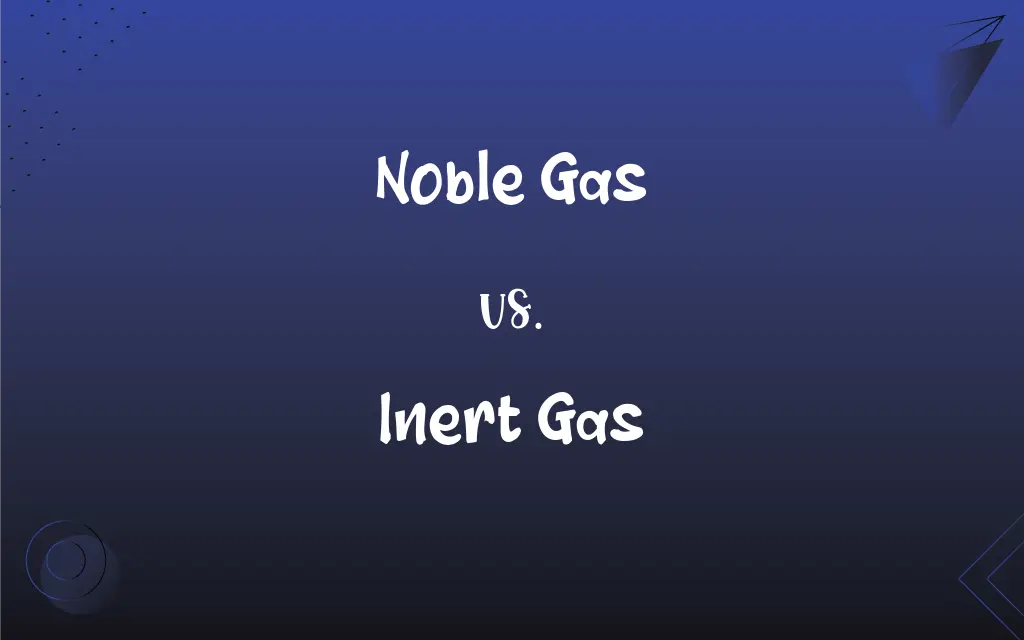Noble Gas vs. Inert Gas: What's the Difference?
Edited by Aimie Carlson || By Janet White || Published on January 8, 2024
Noble gases are a group of chemically inert elements in Group 18 of the periodic table, while inert gases refer broadly to any gases that resist chemical reactions.

Key Differences
Noble gases, specifically found in Group 18 of the periodic table, include helium, neon, argon, krypton, xenon, and radon. These gases are characterized by their complete electron shells, making them highly stable and unreactive. Inert gases, on the other hand, encompass a broader category that includes noble gases but can also refer to other gases like nitrogen under certain conditions that are not chemically active.
All noble gases share a lack of reactivity due to their full valence electron shells, making them nearly inert in chemical terms. They rarely form compounds under normal conditions. Inert gases, as a category, are defined by their resistance to chemical reactions, but this can vary based on environmental conditions; for example, nitrogen can react under high pressure and temperature.
Noble gases are used in lighting, welding, and as inert environments for chemical reactions due to their stability. Helium, for example, is used in balloons and as a cooling medium. Inert gases, including noble gases, are utilized in various industrial processes for their non-reactivity, such as argon in welding and nitrogen in food packaging to prevent oxidation.
Noble gases were discovered and isolated in the late 19th and early 20th centuries, leading to the completion of the periodic table. Their discovery was significant due to their unique chemical inertness. The term 'inert gas' has been used historically to describe gases that do not undergo chemical reactions under set conditions, but its definition can be broader than that of noble gases.
Noble gases are odorless, colorless, and tasteless, and they exist as monatomic gases under standard conditions. While inert gases share these physical properties, the term can include diatomic gases like nitrogen, which, under most conditions, does not react readily despite not being a noble gas.
ADVERTISEMENT
Comparison Chart
Definition
Specific group of elements in Group 18
Broad category of non-reactive gases
Chemical Reactivity
Almost completely non-reactive
Generally non-reactive, varies by condition
Examples
Helium, Neon, Argon, Krypton, Xenon, Radon
Includes noble gases and others like Nitrogen
Typical Uses
Lighting, cooling, inert atmospheres
Industrial processes, welding, food packaging
Electron Configuration
Full valence shells
Not necessarily full valence shells
ADVERTISEMENT
Noble Gas and Inert Gas Definitions
Noble Gas
Noble gases are known for their lack of chemical reactivity.
Neon signs utilize the inert nature of the noble gas neon.
Inert Gas
Inert gases maintain stability under specific conditions.
Nitrogen remains inert in most industrial processes.
Noble Gas
Noble gases have complete valence electron shells.
Helium, a noble gas, is inert due to its full electron shell.
Inert Gas
Inert gases can be monatomic or diatomic.
Helium, an inert and monatomic gas, is used in balloons.
Noble Gas
Noble gases rarely form compounds.
Xenon, a noble gas, forms compounds only under extreme conditions.
Inert Gas
Inert gases include a wide range of non-reactive gases.
Argon, used in welding, is an inert gas.
Noble Gas
Noble gases are characterized by their extremely low reactivity.
Radon, despite being radioactive, is a chemically inert noble gas.
Inert Gas
Inert gases are used for their non-reactivity in various industries.
Argon, an inert gas, provides a protective atmosphere in welding.
Noble Gas
Noble gases are the elements in Group 18 of the periodic table.
Argon, a noble gas, is often used in light bulbs.
Inert Gas
Inert gases are those that resist chemical reactions.
Nitrogen, an inert gas, is used in food packaging.
FAQs
What is a noble gas?
A noble gas is an element in Group 18 of the periodic table, known for its chemical inertness.
What are common uses of noble gases?
Noble gases are used in lighting, as coolants, and in creating inert atmospheres for sensitive chemical processes.
Can noble gases form compounds?
Noble gases rarely form compounds due to their full electron shells, although some compounds of heavier noble gases exist.
Why are noble gases called 'noble'?
Noble gases are called 'noble' due to their remarkable resistance to forming chemical bonds, similar to how noble metals resist corrosion.
How are noble gases different from other gases?
Noble gases differ in their complete valence electron shells, making them highly unreactive compared to other gases.
Can inert gases be used in welding?
Yes, inert gases like argon are commonly used in welding to prevent unwanted chemical reactions.
What makes noble gases ideal for neon signs?
Noble gases like neon emit distinctive colors when electrically excited, making them ideal for lighting and neon signs.
What is an inert gas?
An inert gas is any gas that is not chemically reactive under certain conditions, including noble gases and gases like nitrogen.
Are all noble gases also inert gases?
Yes, all noble gases are considered inert gases due to their low reactivity.
How were noble gases discovered?
Noble gases were discovered in the late 19th century through the study of air's components and the development of spectroscopy.
Why is radon, a noble gas, considered hazardous?
Radon is hazardous due to its radioactivity, which poses health risks, particularly lung cancer.
Do inert gases have any biological role?
Most inert gases do not play a biological role due to their non-reactivity, though they can have physiological effects at high pressures.
Is helium the lightest noble gas?
Yes, helium is the lightest noble gas and the second lightest element.
Are inert gases safe to breathe?
Inert gases are non-toxic, but they can displace oxygen, leading to asphyxiation in confined spaces.
Can inert gases be found in the Earth's atmosphere?
Yes, some inert gases, like argon and nitrogen, are major components of the Earth's atmosphere.
Are noble gases used in medical applications?
Yes, noble gases like helium are used in medical applications, such as in respiratory treatments.
How does xenon, a noble gas, form compounds?
Xenon can form compounds under extreme conditions due to its relatively large atomic size, which allows it to participate in chemical reactions.
Can inert gases be liquified?
Yes, inert gases can be liquified, but they require very low temperatures due to their low boiling points.
What is the most abundant noble gas in the atmosphere?
Argon is the most abundant noble gas in the Earth's atmosphere.
Are inert gases used in space exploration?
Yes, inert gases like xenon are used in ion propulsion systems for space exploration.
About Author
Written by
Janet WhiteJanet White has been an esteemed writer and blogger for Difference Wiki. Holding a Master's degree in Science and Medical Journalism from the prestigious Boston University, she has consistently demonstrated her expertise and passion for her field. When she's not immersed in her work, Janet relishes her time exercising, delving into a good book, and cherishing moments with friends and family.
Edited by
Aimie CarlsonAimie Carlson, holding a master's degree in English literature, is a fervent English language enthusiast. She lends her writing talents to Difference Wiki, a prominent website that specializes in comparisons, offering readers insightful analyses that both captivate and inform.
































































